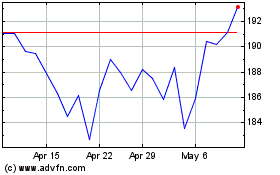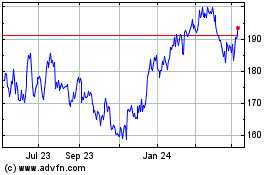By Jack Nicas and Don Clark
The latest batch of tech-industry earnings show how two
technology trends -- mobile and the cloud -- are taking root and
delivering big profits for the companies that bet on them.
Facebook Inc. and Google parent Alphabet Inc. last week both
reported surges in their quarterly profits, fueled by users
spending more time on their smartphones and advertisers spending
more money to reach them there.
Meantime, Amazon.com Inc. and Microsoft Corp. beat Wall Street
estimates with results that were lifted by the strength of their
businesses hosting other companies' data on their computer servers,
also known as the cloud.
"The big are getting bigger," said Ben Schachter, an analyst at
Macquarie Group Ltd. "People are using the internet more and more.
They always have it with them because of smartphones, speeds are
getting better...and all that information has to come from
somewhere, and it comes from the cloud."
The strength of these technologies is intertwined. Mobile
devices are increasingly becoming people's primary computers, which
is driving demand for the cloud. On personal computers, data was
often stored on the device itself, but smartphones have less memory
-- and the consumption of data overall has dramatically increased
-- requiring more information to be stored on the cloud.
The link is more than a decade old but has accelerated sharply
in recent years. The original boom in downloaded songs --
frequently from Apple Inc.'s iTunes service to iPods -- has been
supplanted by an explosion in mobile apps, streaming media services
and other mobile offerings that require the cloud.
"We see mobile and cloud infrastructure going hand in hand,"
said Ben Stanton, an analyst at research firm Canalys. "Cloud
infrastructure is pushing more and more of the capability of the
mobile device." Canalys forecasts that corporate spending on cloud
services rose 52% in the second quarter from a year prior, largely
driven by mobile demands.
Meanwhile, the picture for hardware companies is mixed.
The yearslong shift to smartphones from personal computers has
delivered massive profit for Apple, which introduced the first
iPhone nine years ago. But now smartphone sales have plateaued in
many countries, and Apple is feeling the squeeze. The world's most
valuable company said last week that iPhone sales declined for the
second consecutive quarter after an eight-year run of growth,
pushing profit down 27% from a year prior.
Still, some phone makers reported sales growth, including
Samsung Electronics Co. and Huawei Technology Co. Chip maker
Qualcomm Inc. reported a 22% jump in quarterly profit linked
largely to chip sales for Chinese smartphones.
Overall, the mobile era is entering a phase in which the profits
are increasingly going to internet and software companies that
capitalize on people using their phones more.
Two big winners are Google and Facebook, which are reaping the
rewards from the critical mass of mobile users that is attracting
advertisers.
Facebook said mobile ads accounted for 84% of its $6.2 billion
in advertising revenue in the latest quarter, compared with 11% in
2012. Facebook's profit nearly tripled from a year prior to a
record $2.1 billion.
Mobile growth also drove Google's 21% jump in quarterly revenue.
It said advertisers now are increasingly willing to advertise on
phones, partly because their mobile websites have improved, and
because tech companies like Google are offering better mobile-ad
formats. Google also is drawing advertisers by demonstrating the
efficacy of smartphone ads, like tracking users' locations to see
if they visit physical stores after seeing a mobile ad for those
stores.
While Apple's phone sales are shrinking, its smartphone-services
revenue rose 19% to nearly $6 billion in the second quarter. That
revenue includes app sales, Apple Music subscriptions and Apple Pay
fees. Apple CEO Tim Cook said he expects the business to grow so
much over the next year that it would be a Fortune 100 company if
it were independent.
Revenue at Amazon's cloud business grew 58% to $2.89 billion in
the second quarter, helping fuel Amazon's record $857 million
profit, which nearly doubled the company's previous high. The cloud
business is on track to surpass CEO Jeff Bezo's $10 billion revenue
goal this year.
Microsoft, widely seen as the No. 2 cloud provider after Amazon,
is making its cloud business the centerpiece of a transition beyond
selling software. The segment that includes its Azure
cloud-computing service grew 6.6% to $6.71 billion in the latest
quarter, while the segment including Windows software fell 3.7% to
$8.9 billion. Azure revenue alone nearly doubled.
Google also is aggressively pitching its cloud services, and
recently hired Diane Greene, a well-known Silicon Valley
entrepreneur, to run the division. Revenue for the segment that
includes Google's cloud business increased 33% to $2.17 billion in
the second quarter, outpacing past quarters' growth and increases
in its advertising business.
Some of the losers in the latest round of earnings highlight how
smartphones and the cloud are replacing PCs as Silicon Valley's
major growth driver. Intel Corp., the PC-chip kingpin that failed
to get a foothold in smartphones, reported a 51% drop in profit
because of restructuring charges linked to a strategy to reduce its
dependence on PCs.
Other companies linked to PCs are rapidly shifting to mobile.
One example is Logitech International SA, a longtime maker of PC
peripherals that has recently been adding a range of devices linked
to phones, such as home cameras and wireless headphones.
Logitech reported better-than-expected first-quarter financial
results, including a 7% rise in revenue. Logitech CEO Bracken
Darrell said in an interview, "Everything we do is mobile."
Write to Jack Nicas at jack.nicas@wsj.com and Don Clark at
don.clark@wsj.com
(END) Dow Jones Newswires
August 01, 2016 02:48 ET (06:48 GMT)
Copyright (c) 2016 Dow Jones & Company, Inc.
Macquarie (ASX:MQG)
Historical Stock Chart
From Mar 2024 to Apr 2024

Macquarie (ASX:MQG)
Historical Stock Chart
From Apr 2023 to Apr 2024
